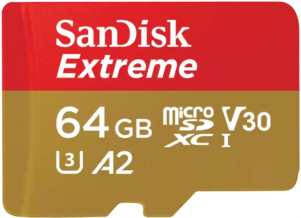- Advertised capacity: 64GB
- Fake/skimpy flash: Skimpy (0.21% skimp)
- Protected area: 134,217,728 bytes
- Speed class markings: U3, V30, A2
- CID data:
- Manufacturer ID:
0x03* - OEM ID:
0x5344(ASCII:SD)* - Product name:
0x534e363447(ASCII:SN64G)
- Manufacturer ID:
| Sample # | 1 | 2 | 3 | Average |
|---|---|---|---|---|
| Obtained from | Amazon | AliExpress | AliExpress | N/A |
| Price paid | $10.43 | $9.60 | $9.60 | $9.88 |
| Logical capacity | 63,864,569,856 bytes | 63,887,638,528 bytes | 63,887,638,528 bytes | 63,879,948,970 bytes |
| Physical capacity | 63,864,569,856 bytes | 63,887,638,528 bytes | 63,887,638,528 bytes | 63,879,948,970 bytes |
| Fake/skimpy flash | Skimpy (0.21% skimp) | Skimpy (0.18% skimp) | Skimpy (0.18% skimp) | Skimpy (0.19% skimp) |
| Adjusted skimp | 0.0019% | -0.03% | -0.03% | -0.019% |
| Product revision | 0x86 | 0x85 | 0x85 | N/A |
| Manufacture date | Sep 2023 | Sep 2023 | Sep 2023 | N/A |
| Serial number | 0xd84929ad | 0xfea61ca2 | 0xfea61c88 | N/A |
| Sequential read speed (MB/sec) | 85.94 | 165.70 | 159.05 | 136.90 |
| Sequential write speed (MB/sec) | 51.68 | 69.00 | 74.29 | 64.99 |
| Random read speed (IOPS/sec) | 3,334.23 | 2,910.07 | 2,795.22 | 3,013.17 |
| Random write speed (IOPS/sec) | 293.81 | 640.39 | 1,154.36 | 696.19 |
| Read/write cycles to first error | 1,269 | Not yet determined | Not yet determined | 1,269 |
| Read/write cycles to complete failure | 5,505 | Not yet determined | Not yet determined | 5,505 |
| Total days to complete failure | 223 | Not yet determined | Not yet determined | 223 |
| Card reader used | SanDisk MobileMate | JJS CR-UTC4AC | JJS CR-UTC4AC | N/A |
| Package front | 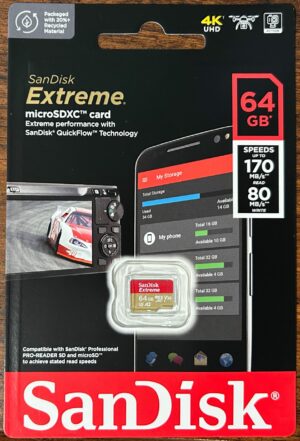 | 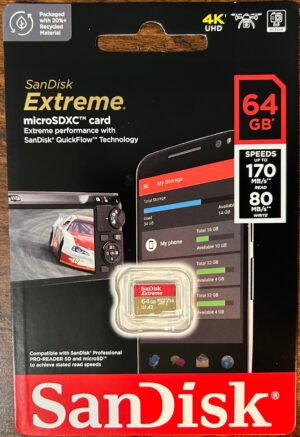 | 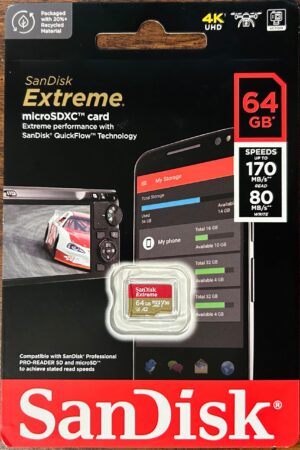 | N/A |
| Package back | 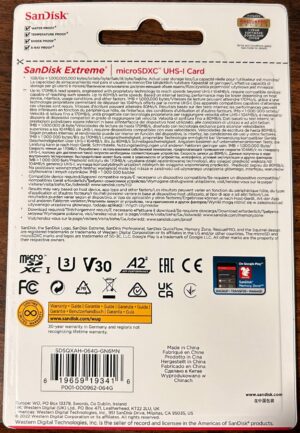 | 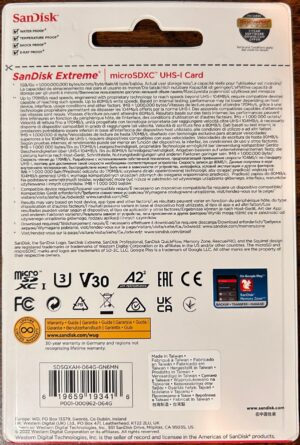 | 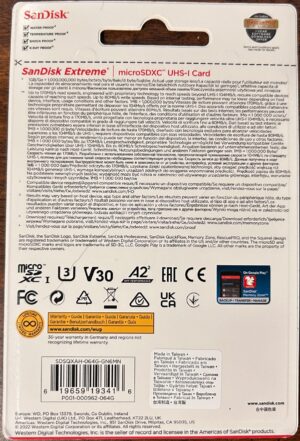 | N/A |
| Card front | 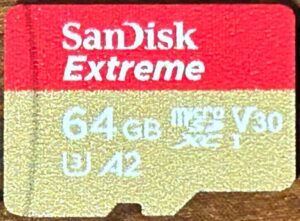 | 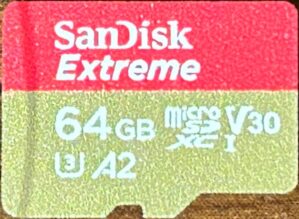 | 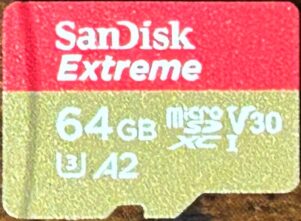 | N/A |
| Card back | 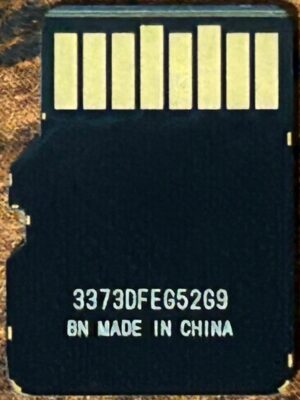 | 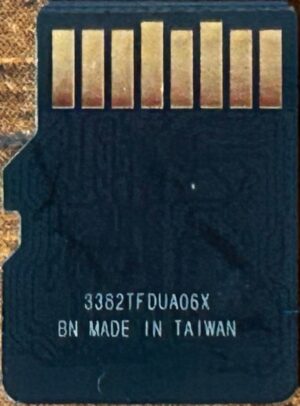 | 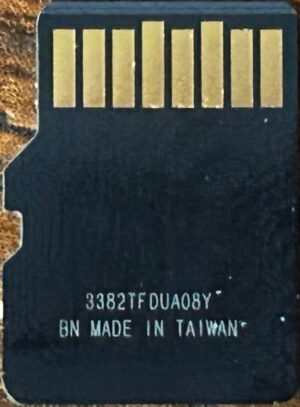 | N/A |
* This manufacturer ID/OEM ID combination is pretty well known to be associated with SanDisk.
Discussion
Continuing my (hopefully objective) evaluation of SanDisk cards, I purchased both the 32GB and the 64GB versions of this card. As I alluded to earlier, I purchased the 64GB version for a very particular reason.
SanDisk has a “gimmick” with some of their cards: they’re UHS-I cards, but SanDisk advertises speeds that are beyond what should be possible under the UHS-I spec. Under UHS-I, the maximum clock speed for an SD card is 208MHz, and SD cards have four lines for transferring data — which means that the maximum possible speed should be 832Mbit/sec, or 104MB/sec. However, this card advertises that it can get read speeds of up 170MB/sec and write speeds of up to 80MB/sec. I don’t know exactly how they do this, but if you look closely at the package, there’s an asterisk: it requires a “compatible device capable of reaching such speeds”. There’s also a note on the front of the package that says “Compatible with SanDisk Professional PRO-READER SD and microSD to achieve stated read speeds”. I suspect that these card readers have some mechanism to detect whether the card is one that should support these higher speeds; if they do, I suspect that the reader simply overclocks the card to get those speeds.
I don’t have one of the SanDisk Professional PRO-READER SD or microSD readers; however, I do have several SanDisk MobileMate microSD readers — and on the package, it says — quite prominently — “Enables SanDisk enhanced UHS-I microSD card speeds”. This should mean that I should be able to use this reader with this card and get the speeds they advertise (or close to it), right? Well…nope. Actual read/write speeds only got about halfway to the maximum stated on the package.
Compared to the other cards in my collection, sequential read and sequential write speeds were above average, with sequential write speeds being more than one standard deviation above average. Random read speeds were more than one standard deviation above average as well; however, random write speeds were slightly below average. Compared to the other name-brand cards that I tested, sequential read and random write speeds were below average. While this is good enough for the U3 and V30 marks that it carries, the A2 mark requires random read speeds of 4,000 IOPS/sec and random write speeds of 2,000 IOPS/sec — and this card fell well short of that.
Side note: no card I’ve tested so far has met the performance thresholds for the A2 mark. To reach the speeds required for the A2 mark requires some pretty advanced features of the SD spec, which probably requires hardware beyond what I have. However, this card’s random write speeds weren’t even good enough for the A1 mark — and seeing as how I have other cards in my collection that did meet the threshold for the A1 mark, I doubt that it would have performed well enough for the A2 mark even if it had been tested under the right conditions.
Sample #1 was doing fairly well for quite some time; however, at some point I had to shut down the host machine so that I could install some new equipment. When I powered the host machine back up, the card would no longer respond to commands. This isn’t helping the whole “SanDisk cards are prone to fail when subjected to brownout” theory — but at the same time, this card wasn’t doing anything when it was disconnected, and it had been working just fine right before then.
Endurance tests for samples #2 and #3 are still ongoing:
- Sample #2 has survived 5,001 read/write cycles so far and has not yet experienced any errors.
- Sample #3 has survived 2,229 read/write cycles so far and has not yet experienced any errors.
July 20, 2024 (current number of read/write cycles is updated automatically every hour)

